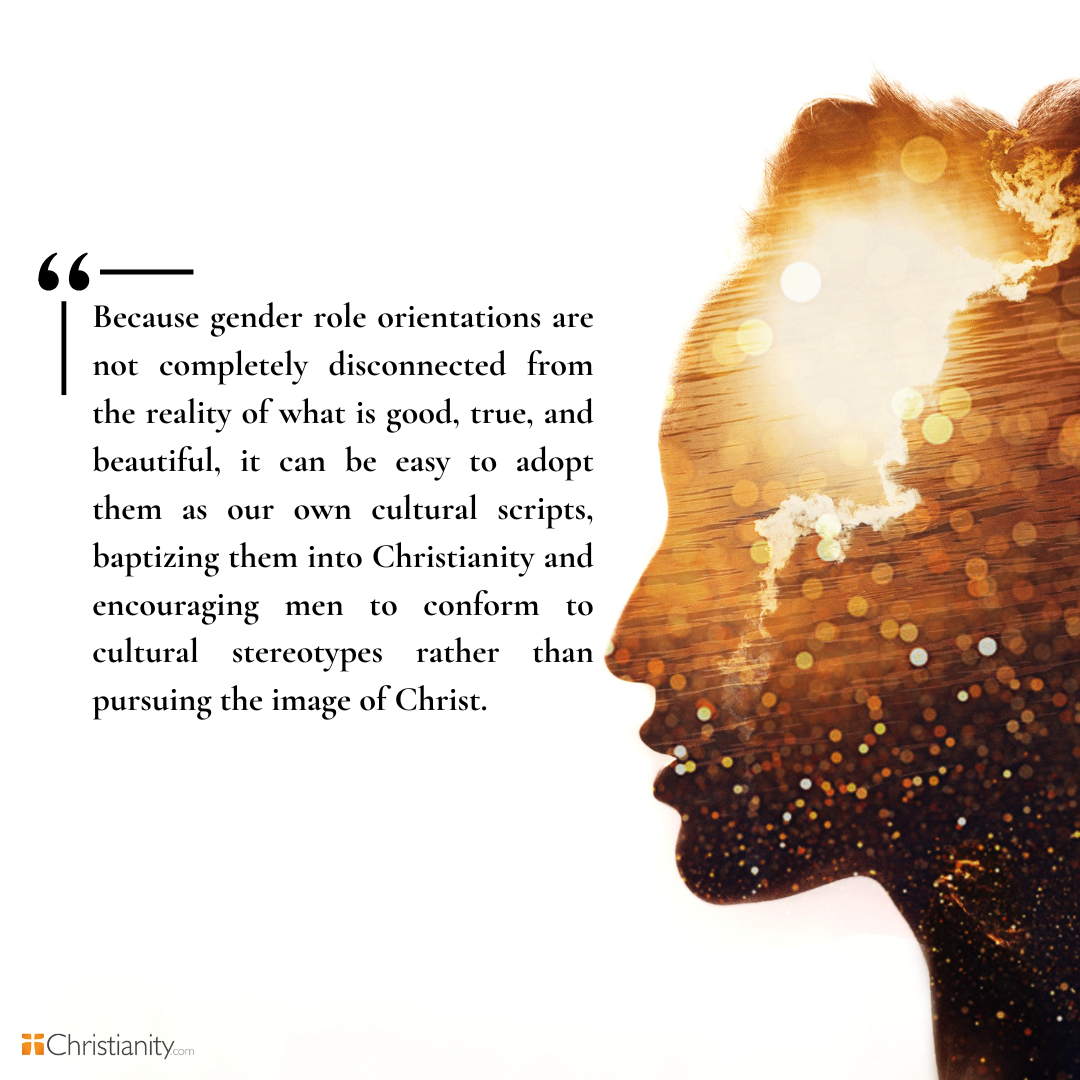When I was in the fifth grade, I remember asking a girl out on a date—or asking one of her friends to ask her to go out on a date for me. While the girl declined the invitation, it was the reason given for the response that stuck with me. She thought I was too “girly.” Admittedly, I was a bit of a late bloomer. I wasn’t particularly good at sports. I was a bit more “bookish” and tended to excel at art, particularly sketching. I wasn’t overly aggressive, either, tending to avoid conflict rather than seeking it out. Looking back, the description of “girly” made some sense. Or did it?
As I got older, I continued to draw, sketch, and read, but I found that I also loved the weight room. When I went to college as a pre-med chemistry major, I eventually found my space as an Exercise Physiology major. I worked my way through my MDiv as a personal trainer and continued lifting as I completed my MA degree in Biblical Exegesis at Wheaton College and my PhD in Theological Studies at Trinity Evangelical Divinity School.
At 47, I weigh in at a reasonably lean 215lbs, qualified for the 1000lbs club (sum of deadlift, squat, and bench press equals 1000lbs or more), and have tattoos covering three-quarters of both my arms. When I look back on my fifth-grade self, it would be easy to agree with the girl who turned me down for a date—it would be easy to agree that I was “girly.” But why? The answer: the ubiquity and persistence of masculine and feminine stereotypes.
Ultimately, my interest in this topic has little to do with an incident that occurred in the fifth grade. Instead, I come to this topic having been challenged by family, friends, and colleagues to consider when and how I have been aping masculine cultural stereotypes rather than conforming to the image of Christ. Being married to a woman who has experienced a high level of professional success, raising daughters, and working within evangelical circles for most of my career have certainly given me some insight into the challenges both women and men face inside and outside the church.
As I began to look into these matters, I started reading books and journal articles, as well as watching sermons and lectures on masculinity on YouTube and various podcasts. I also had some guests on my own podcast—Thinking Christian—as part of my research process. Eventually, I ran across some of Mark Driscoll’s videos on YouTube and then purchased his book titled Act Like a Man. While I don’t disagree with Driscoll on every point, I’ve chosen to use his work as a running example of the sort of assumptions that often drive conversations about Christian manhood. My goal is not to demonize Driscoll, but to use an easily accessible, non-technical body of work to illustrate some of the challenges I see in Christian presentations of manhood.
In choosing Driscoll, who represents a more conservative stance, I am also not endorsing more liberal treatments of Christian manhood. My goal is not to sway God’s people to adopt one or another cultural conception of masculinity, but to think biblically about these matters so that what it means to be a man emerges from discipleship. Discipleship is the process of learning to live under the authority of Christ. As such, discipleship will always position us at a unique angle to the various ideas presented within our cultures and societies. It isn’t that non-Christians always get “it”—whatever “it” may be in mind—wrong, but that “it” will always be incomplete and require expansion or correction apart from Christ. In these articles, “it” is the cultural stereotypes associated with masculinity.
An Excursus on the Language of Masculine and Feminine Language
The language of gender—masculinity (or manhood) and femininity—will be used throughout this series of articles. In truth, it is difficult to avoid because it is so ingrained in our cultural expressions. At times, these stereotypes may encourage characteristics that overlap with biblical norms; however, Christians would be wise not to view them as authoritative or aspirational standards. Instead, the traits associated with masculinity are often misaligned with, contradictory to, or completely missing from the scriptures.
The literature on masculinity and femininity tends to reflect social perceptions rather than identifying some enduring plumb line for what it means to be male or female in a given context. The stereotypes associated with “masculinity” and “femininity” reflect societal standards that can and do change over time while still exhibiting a certain stability. Even so, these cultural expectations have negative impacts on those who seek to live up to them (see “APA Guidelines for Psychological Practice with Boys and Men”).
Adding to the confusion associated with gender role orientations is the application of the language of masculinity to both biological males and biological females. This problem isn’t simply modern but was evident in the ancient world as well (see Susanna Asikainen, Jesus and Other Men). This application of language across biological sexes highlights the culturally constructed nature of gender role orientations. Whatever correlations there may be between one’s biological sex and specific characteristics, it is difficult to identify any one characteristic (e.g., aggression, empathy) with only one biological sex, begging the question of whether categorizing specific characteristics as masculine or feminine is even beneficial.
Masculine and Feminine Stereotypes
In his lecture “Maybe We Just Need a Different Chicken…Politeness and Civility in the Function of Contemporary Ideology,” philosopher and cultural critic Slavoij Žižek argues that ideologies influence the questions we ask about the real problems we face. He suggests, “The lesson is that there are not only wrong answers to questions. There are also wrong questions I the sense that the way we perceive a problem, which can be a very real problem, is effectively a part of the problem.” Framing masculinity or femininity as ideologies suggests that they reflect an underlying set of values and characteristics, a reflection of a particular culture, that is, and not necessarily connected to biological sex.
Returning to the question of why being labeled “girly” as a fifth grader makes sense, then, when viewed from the perspective of gender ideology. A more sophisticated way to say “girly” would have been to say the fifth-grade version of myself didn’t exhibit the culturally determined values and characteristics stereotypically signifying someone as “a male.” While there isn’t a single definition of masculinity, Levant and Richmond suggest that there is “a common constellation of standards and expectations associated with the traditional male role in the Western world.” These common standards and expectations include: (1) avoiding “feminine” things, (2) orientation toward success and achievement, (3) portrayal of strength and avoiding the appearance of weakness, and (4) the pursuit of adventure and the use of violence when necessary.
Masculinity ideologies don’t seem to be particularly helpful, even when decoupled from sex. For example, a 2024 study found that gender role orientations had a greater effect than sex on aggression in both males and females. Females with characteristics associated with traditional masculinity exhibited higher levels of aggression than females with characteristics associated with traditional femininity. As males and females seek to conform to societal standards of masculinity—and, presumably, femininity—they may not be acting out their sex but running a cultural script. Though sex—or nature—is not unimportant, this research points to the influence of culture—or nurture—on the dispositions that men and women adopt. Playing into existing notions of masculine and feminine cannot be the church’s strategy. Instead, we must allow discipleship to mold us into male and female followers of Christ under the authority of God’s word, not under the thumb of a set of cultural expectations.
Gender role orientations (e.g., masculinity ideologies) have a formative function guiding individuals toward values that often misrecognize the good, the true, and the beautiful to some extent. I say “to some extent” because the pictures of “ideal” masculinity and femininity do not necessarily reflect a complete detachment from reality, but a partial rendering of reality created as humans selectively decide on what aspects of the good, the true, and the beautiful they will allow to have a claim over them. “Goodness” becomes subject to our choices rather than governing over them. As D. C. Schindler explains in Freedom from Reality,
“One sometimes hears the rather glib complaint that modern freedom represents a rejection of all constraints: people think you can just do whatever you want, whatever “feels good,” regardless of the consequences it might have for oneself or for others. This is not the criticism we are making; the point here is more subtle. To say that the goodness of the options is effectively a function of the will’s choice is compatible with a recognition of all sorts of constraints on that choice; it is simply a denial of the very specific “constraint”—which we have suggested is at the same time an “empowering”—of actual goodness.”
Masculinity and femininity may well be gesturing toward the good, true, and beautiful. Their conceptualization is not problematic because they have no connection to these realities, but because they are only selectively guided by them. In other words, the option—the selection of cultural values and characteristics associated with masculinity and femininity—is misrepresented as the good.
Because gender role orientations are not completely disconnected from the reality of what is good, true, and beautiful, it can be easy to adopt them as our own cultural scripts, baptizing them into Christianity and encouraging men to conform to cultural stereotypes rather than pursuing the image of Christ. Such encouragement is a subtle legitimation of a type of “masculinity” that creates misperceptions about what it means to “act like a man.” Consider, for instance, the following passage from Mark Driscoll’s Act Like A Man:
“True or false: Can women feel comfortable in a masculine environment if its not angry or aggressive? True. Can you take your girlfriend to a sports bar? Yes. Do comfortable, healthy heterosexual normal men feel comfortable in a profoundly feminine environment? No. I’ve never seen a healthy guy ask his gal, ‘Can I go to the nail salon with you?’ If your’re that guy, you need to know, with the full love of Jesus, you are a weirdo.”

I must be a weirdo, because, having been married for almost twenty-five years and having raised twin girls for the past sixteen years, I am absolutely happy to go anywhere and do anything with my wife or my daughters. Do I always enjoy it? Not necessarily. For instance, my wife and daughters enjoy going to amusement parks and riding roller coasters. Aside from the water rides, hot pretzels, and waffle cones, I could do without amusement parks and, in particular, the roller coasters.
If spending time with my wife and daughters means I need to get a manicure or pedicure, I am 100% comfortable heading to the nail salon. Driscoll’s statement and, in my estimation, much of his book, are built on underlying assumptions about masculinity justified by scripture but not rooted in it. While Driscoll would likely agree that manhood should be rooted in and emerge from Christian discipleship, I believe he would want to advance a cultural picture of what sort of man would emerge from such discipleship. However, there is much to agree with in Act Like a Man, such as the call to be responsible husbands and fathers, if one decides to get married and have children. However, when Driscoll says that the Church is to “be a countercultural subculture where men are masculine” and “women are feminine,” it is difficult to understand just what he means by “masculine” and “feminine.”
For example, at one point, Driscoll discusses emotions. He rightly notes that expressing emotion is appropriate for men. He offers a critique about “unhealthy men” who assume that there are “feminine and masculine emotions” (e.g., men don’t cry or show affection). This seems to be a plausible extension of particular masculine ideologies (e.g., not showing weakness). However, Driscoll closes the paragraph noting, “Men and women both bear the image and likeness of God and have the same emotions; they’re just expressed in masculine and feminine ways.” While it may be tempting to say “amen” and move on, it is important to recognize that, apart from a cultural script about gender role orientations, what it means to express emotions “in masculine and feminine ways” is nonsensical. Can we really identify Jesus’s tears at the death of Lazarus (Jn 11:35) as masculine and the weeping of Mary during the same incident (11:32-33) as feminine? Aside from the difference in their sex (i.e., Jesus was male and Mary female), there is no indication that Jesus weeps in a masculine way while Mary weeps in a feminine way. Both just wept.
At various points, it seems that Driscoll’s work has less to do with biblical manhood and more to do with “machismo”—a sort of bravado that uses the scriptures to reinforce cultural stereotypes rather than challenging them. Even the book’s subtitle—"9 Ways to Punch Life in the Mouth”—gestures toward a sort of “manly” swagger. Yes, Driscoll’s book contains some good insights, but those insights are too often blunted by the cultural assumptions about masculinity that seem to be both implicit and explicit through Act Like a Man. Rather than push toward a robust biblical understanding of how men can point to and glorify God, the book tends to encourage men to reject a liberal notion of “gender” (not a bad thing) and embrace a more “conservative” or “traditional” idea of masculinity that isn’t necessarily aligned with scripture (almost certainly a problem).
Throughout this series of articles, I’ll be arguing for a way of being male in the world that emerges from discipleship. Often, such a way of being male in the world will mean rejecting the sort of “machismo” that thinks “punching life in the mouth” is an expression that should appeal to Christian men. We don’t need to reinforce stereotypically masculine ideas. Instead, we need to recognize that (1) being a Christian woman or Christian man can only emerge from discipleship and (2) what it means to be a Christian woman or man is not something we can tie to one’s level of comfort at a nail salon.
Photo Credit: ©Getty Images/Red Goldwing




.jpg)
